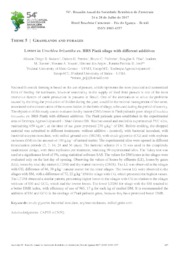Losses in Urochloa brizantha cv. BRS Piatã silage with different additives.
Losses in Urochloa brizantha cv. BRS Piatã silage with different additives.
Author(s): SEDANO, A. D. B.; PEREIRA, D. H.; PEDREIRA, B. C. e; PINA, D. S.; XAVIER, I. M.; SOUZA, H. A.; ANJOS, E. dos; JOSÉ, R. P. D.
Summary: National livestock farming is based on the use of pasture, which represents the most practical and economical form of feeding for ruminants, however seasonality in the supply of food from pasture is one of the most restrictive factors of cattle production in pastures in Brazil. One of the alternatives to solve the problems caused by the irregular production of fodder during the year, would be the rational management of the same, associated to the conservation of the excess fodder, in the form of silage, to be used during the period of scarcity. The objective of this study was to evaluate the dry matter (DM) losses in Piatã palisade grass silage (Urochloa brizantha cv. BRS Piatã) with different additives. The Piatã palisade grass established in the experimental area of Embrapa Agrossilvipastoril ? Mato Grosso/BR. Was harvested and ensiled in experimental PVC silos, maintaining 650 kg.m-3, at the time of cut grass presented 230 g.kg-1 of DM. Before ensiling, the chopped material was submitted to different treatments: without additive - (control), with bacterial inoculant, with bacterial anzyme-inoculant, with milled ground corn (MGM); with crude glycerine (CG) and with soybean molasses (SM) in the amount of 100 g.kg-1 of natural matter. The experimental silos were opened in different fermentation periods (3, 7, 14, 28 and 56 days). The factorial scheme (6 x 5) was used in the completely randomized design, with three replicates per treatment, totalizing 90 experimental silos. The Tukey test was used at a significance level of 5%, using statistical software SAS. The values for DM losses in the silages were evaluated only on the last day of opening. Observing the values of losses by effluents (LE), losses by gases (LG), losses by total dry matter (LTDM) and dry matter recovery (DMR). The LE was observed in the silages with CG, difference of 46, 30 g.kg-1 natural matter for the other silages. The lowest LG were observed in the silages with SM, with a difference of 72, 22 g.kg-1 DM for silage with CG, which presented the highest values. The LTDM obtained a similar pattern, presenting higher losses in the silages with CG in relation to the silages with use of SM and GCG, which had the lowest losses. The lower LTDM for silage with the SM resulted in a better DMR index, with efficiency of use of 965, 17 g for each kg of ensiled DM. It is recommended the addition of SM and GCG in the ensilage of Piatã palisade grass, because they have promoted better DMR.
Publication year: 2017
Types of publication: Abstract in annals or event proceedings
Keywords: Bacterial inoculant, Corn, Crude glycerin, Glycerin, Milled grain corn, Soybeans, Soybeans molasses
Observation
Some of Embrapa's publications are published as ePub files. To read them, use or download one of the following free software options to your computer or mobile device. Android: Google Play Books; IOS: iBooks; Windows and Linux: Calibre.
Access other publications
Access the Agricultural Research Database (BDPA) to consult Embrapa's full library collection and records.
Visit Embrapa Bookstore to purchase books and other publications sold by Embrapa.

